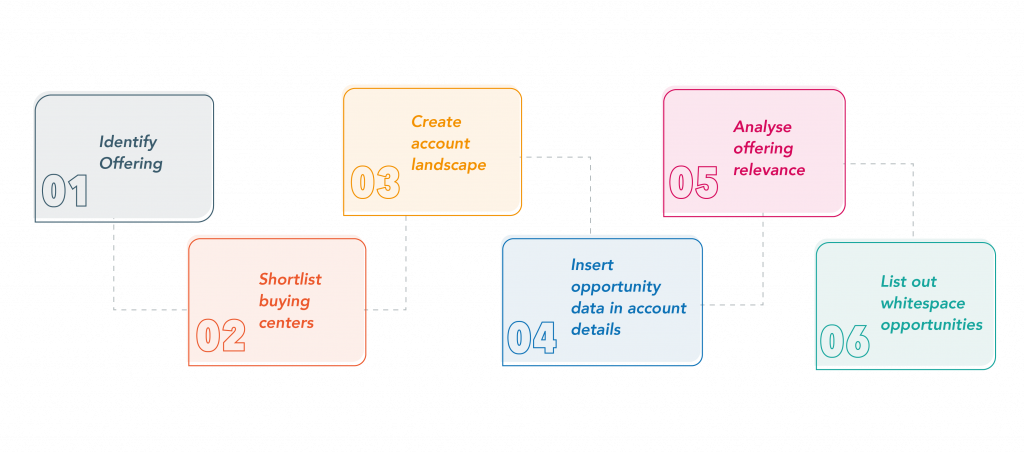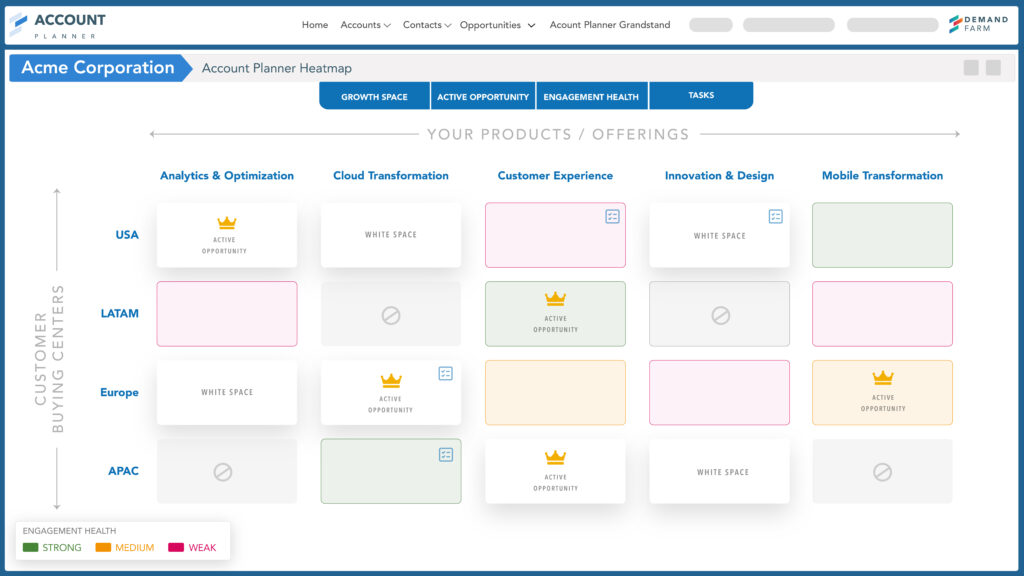Key account managers are always seeking ways to drive growth and deliver value to their accounts. While acquiring new customers is exciting, maximizing the potential of existing accounts is often the most strategic and profitable approach. Retaining and expanding relationships with your current customer base reduces acquisition costs while deepening trust and loyalty.
One of the most effective ways to achieve this is by identifying White Space Opportunities—gaps in your customer’s current investment with your offerings. These represent unmet needs or untapped potential that, when addressed, foster growth for both your company and your customers, while strengthening long-term relationships.
What are White Space Opportunities?
Selling to existing accounts is more cost-effective than acquiring new ones. It demands less time, fewer resources, and minimal effort while delivering significant returns.
Key Account Managers are increasingly focusing on identifying White Space Opportunities—areas within their accounts to upgrade, upsell, or cross-sell their services.
These gaps represent overlooked solutions or unmet needs that can drive value and growth. By addressing these gaps, businesses not only generate additional revenue but also reinforce their position as a trusted partner, delivering tailored solutions that align with their customer’s evolving goals.
If Opportunity Doesn’t Knock, Build a Door!
White Space actually means different things to different people. Some think of white space as an open playing field, with no competition. A few look at it as an untapped market. But the general consensus is that white space refers to the gap between what your existing customers have already bought from you and what other unique products and services you can offer them.
More details about White Space in Business can be found here.
While in editing and publishing, white space is also referred to as negative space, in business these gaps are seen as opportunities. These gaps can mean the opportunity to offer a product to a customer that has never used it, reconsider how a product or service can be used or offered or focus on under-utilized services or product features. Sometimes these opportunities can easily be identified. At other times, depending on the sector you’re in, it may need some effort, thought and ingenuity.
Sales teams are extremely adept at finding White Space Opportunities because of a thorough understanding of the product. Being in contact with customers and understanding their current and future needs, they can suggest changes or tweaks in products in a way that would most appeal to customers.
Here’s how you can align White Space Opportunity with your growth potential.
What is White Space Analysis and what does white space mean in business?
White Space Opportunities are identified through a process called White Space Analysis. This process helps companies discover possibilities among their existing customer base to cross-sell and upsell. It also uncovers accounts that may need more attention and focus.
While it is always satisfying to bring in new customers and business opportunities, it is important not to ignore your existing customer base when looking for revenue-generating avenues. This practice gained importance during the Covid-19 pandemic when selling practices changed drastically.
Companies started nurturing their existing customers to try and create new growth opportunities for themselves. Customers were equally pleased to stay with a company they had already tried and tested, rather than seek out a new product or service provider.

How do you identify white space opportunities using white space analysis
There are a few steps if you want to know how to do white space analysis:
1. Understand your current status
An effective analysis begins with what your current position is. You will need to collate and analyze customer data using the Best customer data platform to gain insights into your existing customers’ investments in your company. If you don’t have this level of customer data at hand, getting it organized could be a time-consuming task, but an essential and invaluable one. If you have a large customer base, start this exercise with those customers that have the highest potential for investment in the future.
Once you have this data, you will be able to identify which product or service your customers have invested in – and to what extent. You can segregate this data by:
- The size of your customers’ organizations
- The sector your customer’s business is in
- The type of opportunity they represent
- The products or services purchased
- When they bought with you
All this data properly charted out and visually represented will give you a better understanding of white space opportunities.

2. Identify customer accounts
White space analysis is an elaborate process. It requires a thorough understanding of what your customers need and how you can position what you offer to meet that need. You may need to further explore your customers’ needs, for example, by the areas or regions they are based in. Or by the opportunity type, they represent i.e., long-term customers, new customers etc. and the added investment they are likely to make.
Understanding the customer’s business is also important at this stage. For example, are they looking to expand their company? Are they consolidating their business? Are they traditional and hierarchical companies? Are they more modern and flexible? Once you have a thorough understanding of your customer’s current investments in your products and services and knowledge of their needs – you’ve identified your opportunities! You can now cross-sell and up-sell your products or services. This exercise also allows you a better understanding of how you can reposition your own products, add or alter product features, and introduce upgrades and enhancements.
3. Analyze the selected customer accounts
Once you’ve identified which customer accounts have the highest potential and are keen on future investments, you can go one step further.
Identify which centers or units within your customer’s business make their own buying decisions. These can be based on departments, divisions, or regions. To make this distinction, you will also need to have information like where and how decisions are made, and budgets allocated to each unit. Knowledge of the organizational structure and power dynamics is extremely beneficial during this exercise.
Examine both closed accounts and open opportunities to define which accounts or which sections of which accounts you can approach. Identify the products or services you can present to them for needs they may have or that you’ve identified for them.
4. Make a detailed representation of your analysis

With all the data and information you have or have gathered it’s time to take effective action. You will need to make lists of all your products/services and all your key accounts, or the buying centers identified. This will result in a matrix which will visually represent the areas of opportunity for you. You can use color codes or words to mark cells and identify opportunities by type. This is an easy way of identifying opportunities by type (e.g., active, closed etc.) or by process (targeting, closing etc.) and by customer.
After this matrix is complete, you will need to appraise how applicable and useful the products/services that you plan to pitch to your target customers are. The objective is not simply to generate revenue in the short term but to position yourself as a business partner with your customers’ best interests at heart.
So, present them with opportunities or future needs you’ve identified for them and then highlight your products or services that help meet these needs. When you’ve identified a strong match between one of your offerings and your customer, make sure you also explain why they should choose you. Focus on your relationship – this is an edge you have over your competitor, but also detail all the benefits of them using what you have to offer.
Once you have completed your White Space Analysis, you will have detailed insight into your customers, and also a visual representation of the opportunities available to you. It also becomes easier for you to target individual buying centers, which is a massive opportunity. Even though the company as a whole may not be looking at major investments, individual divisions or departments could still be interested. After you’ve identified your opportunities, you can create a plan on how to work on them.
Identifying Your White Space Opportunities
We’ve discussed how White Space Analysis is a process that needs commitment of time, effort and resources. The checklist below will help you stay on track and make the most of this extensive project.
-> Get feedback from existing customers
-> Revamp your existing offerings
-> Redefine your customer base
-> Re-evaluate your competitive advantage
Here’s why:
- Listening to your customers is the best way to find out what’s working best and what needs improvement. Having invested in your offerings they know what’s lacking versus what they need. When you have an open line of communication with them, you can use their feedback to build stronger and more robust offerings. You are also able to strengthen your relationship with them.
- With customer feedback as the background, you can look at your existing product line or service menu through different lenses. Have you received any suggestions that are actionable and would benefit you? Is any service redundant? Can any innovations be made to your products? With all the ideas you receive, you can have short, medium and long-term plans to strengthen your offerings.
- If you are making changes to your current offers, you could also re-examine the audience you are offering them to. You don’t have to make a major shift. You could look at defining smaller segments within your existing customer base or expanding it.
- One of the outcomes of the White Space Analysis is the identification of opportunities your competitors can exploit. This helps you strengthen your strategy and focus on the benefits your products/services offer. You can revisit all the features that once allowed you to stand out and ascertain if that still holds true.
Put it to Good Use!
While pursuing and closing new business is always thrilling, there’s plenty of research to strongly encourage you to look within your existing customer portfolio for business opportunities and revenue growth. Plus, you already have access to them!
Using White Space Analysis, you can:
- Identify existing customers with unmet needs: You will be in a better position to understand whether the product/service an existing customer has invested in, actually meets all their needs.
- Refine your sales strategy with opportunities for cross-selling and upselling: White Space Analysis is a big boon to the sales process because it identifies customers who can be sold products/services correlated to what they’ve already purchased (cross-selling). It also allows sales teams to pitch more premium versions of what the customer is interested in or has purchased (up-selling). Every time you can cross-sell or upsell you eliminate a portion of your white space!
- Encourage innovation: The process of analyzing internal, external and future perspectives cascades into developing solutions, improving existing products and services, designing new offers and more. This requires imagination, resourcefulness and creativity.
- Create a better customer experience: Maintain a connection with your customers and get feedback from them. This demonstrates your interest and intention to serve them better. While offering them solutions to their current needs, you exhibit an understanding of how they operate and what they need. When you present them with solutions to future challenges you showcase yourself as an ally invested in their growth and development. In this way, you are able to keep your customers happy and loyal.
Dealing with Unpopularity
Despite all the benefits to be had from this process, many companies are hesitant to implement it. Quite a few of them try it out, but don’t take it to completion. One of the main reasons is that basic data and information about customers are not easily available. Depending on the size of the organization and the customer base, it could be a herculean task to put this all together. And since that’s the primary step, most companies are put off right at the beginning.
In addition to getting all this data together, there are doubts about whether the gains from this process will match the effort that’s being expended. This holds companies back from actively finding and using White Space Opportunities. After White Space Analysis has been done companies must assign resources to make the best use of the opportunities uncovered. If not properly planned and implemented, it could mean that all the time, resources and effort used were in vain!
Making Use of Technology
Many of the deterrents to using White Space Analysis and exploiting White Space Opportunities can be sorted by the use of technology. There are various software and apps available that can be used in conjunction with your CRM, allowing you to identify white spaces in your business. Look for what best suits your level of business, your line-up offerings, and your customer base.
White Space Analysis for Key Account Management
With the many ways in which data and information can be analyzed and organized, White Space Analysis is extremely interesting and stimulating. It fits really well into the whole Strategic Account Management System because during the process of White Space Analysis accounts are identified that can be tapped into for their potential in future investments.
Accounts that need attention and nurturing can also be highlighted and this can be of great importance to your Key Account Management strategy.
The company is better aware of how to allocate resources to manage and retain its key accounts. White Space Opportunities also allow you to rethink your products and services, add features, upgrade, and be innovative.
If used efficiently and backed by proper communication, the White Space Opportunities defined through White Space Analysis take you one step closer to being a business partner of choice for your customers!
 On-Demand Webinar: Unfiltered take on AI in Account Planning: Meet DemandFarm’s KAM AI
On-Demand Webinar: Unfiltered take on AI in Account Planning: Meet DemandFarm’s KAM AI 


